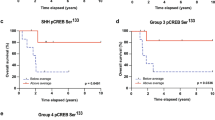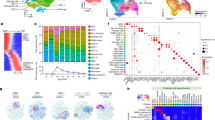Abstract
Medulloblastoma is the most common malignant brain tumor in childhood, and development of targeted therapies is highly desired. Although the molecular mechanisms of malignant transformation are not fully understood, it is known that medulloblastomas may arise from cerebellar granule neuron precursors. The homeodomain transcription factor Barhl1 is known to regulate migration and survival of granule cell precursors, but its functional role in medulloblastoma is unknown. We show here that the expression of BARHL1 is significantly upregulated during human cerebellar development and in human medulloblastoma samples as compared with the normal adult cerebellum. We also detected high levels of Barhl1 expression in medulloblastomas of Math1-cre:SmoM2 mice, a mouse model for Sonic hedgehog-associated medulloblastomas that we developed previously. To investigate Barhl1 function in vivo during tumor development, we generated Barhl1−/−Math1-cre:SmoM2 mice. Interestingly, tumors that developed in these mice displayed increased mitotic activity and decreased neuronal differentiation. Moreover, survival of these mice was significantly decreased. Similarly, low expression of BARHL1 in human medulloblastoma cases was associated with a less favorable prognosis for patients. These results suggest that the expression of Barhl1 decelerates tumor growth both in human and in murine medulloblastomas and should be further investigated with respect to potential implications for individualized therapeutic strategies.
This is a preview of subscription content, access via your institution
Access options
Subscribe to this journal
Receive 50 print issues and online access
$259.00 per year
only $5.18 per issue
Buy this article
- Purchase on Springer Link
- Instant access to full article PDF
Prices may be subject to local taxes which are calculated during checkout





Similar content being viewed by others
References
Bulfone A, Menguzzato E, Broccoli V, Marchitiello A, Gattuso C, Mariani M et al. (2000). Barhl1, a gene belonging to a new subfamily of mammalian homeobox genes, is expressed in migrating neurons of the CNS. Hum Mol Genet 9: 1443–1452.
Chellappa R, Li SG, Pauley S, Jahan I, Jin KX, Xiang MQ . (2008). Barhl1 regulatory sequences required for cell-specific gene expression and autoregulation in the inner ear and central nervous system. Mol Cell Biol 28: 1905–1914.
Corrales J, Rocco G, Blaess S, Guo Q, Joyner A . (2004). Spatial pattern of sonic hedgehog signaling through Gli genes during cerebellum development. Development 131: 5581–5590.
Crawford JR, MacDonald TJ, Packer RJ . (2007). Medulloblastoma in childhood: new biological advances. Lancet Neurol 6: 1073–1085.
Eberhart CG, Kaufman WE, Tihan T, Burger PC . (2001). Apoptosis, neuronal maturation, and neurotrophin expression within medulloblastoma nodules. J Neuropathol Exp Neurol 60: 462–469.
Gibson P, Tong Y, Robinson G, Thompson MC, Currle DS, Eden C et al. (2010). Subtypes of medulloblastoma have distinct developmental origins. Nature 468: 1095–1099.
Gilbertson RJ . (2004). Medulloblastoma: signalling a change in treatment. Lancet Oncol 5: 209–218.
Hartmann W, Koch A, Brune H, Waha A, Schüller U, Dani I et al. (2005). Insulin-like growth factor II is involved in the proliferation control of medulloblastoma and its cerebellar precursor cells. Am J Pathol 166: 1153–1162.
Heine VM, Rowitch DH . (2009). Hedgehog signaling has a protective effect in glucocorticoid-induced mouse neonatal brain injury through an 11betaHSD2-dependent mechanism. J Clin Invest 119: 267–277.
Jeong J, Mao J, Tenzen T, Kottmann AH, McMahon AP . (2004). Hedgehog signaling in the neural crest cells regulates the patterning and growth of facial primordia. Genes Dev 18: 937–951.
Kool M, Koster J, Bunt J, Hasselt NE, Lakeman A, van Sluis P et al. (2008). Integrated genomics identifies five medulloblastoma subtypes with distinct genetic profiles, pathway signatures and clinicopathological features. PLOS One Aug 3: e3088.
Li S, Qiu F, Xu A, Price SM, Xiang M . (2004). Barhl1 regulates migration and survival of cerebellar granule cells by controlling expression of the neurotrophin-3 gene. J Neurosci 24: 3104–3114.
Li SG, Price SM, Cahill H, Ryugo DK, Shen MM, Xiang MQ . (2002). Hearing loss caused by progressive degeneration of cochlear hair cells in mice deficient for the Barhl1 homeobox gene. Development 129: 3523–3532.
Louis DN . (2007). WHO Classification of Tumours of the Central Nervous System. IARC Press: Lyon.
Mao J, Ligon KL, Rakhlin EY, Thayer SP, Bronson RT, Rowitch D et al. (2006). A novel somatic mouse model to survey tumorigenic potential applied to the Hedgehog pathway. Cancer Res 66: 10171–10178.
Millen KJ, Hui CC, Joyner AL . (1995). A role for En-2 and other murine homologues of Drosophila segment polarity genes in regulating positional information in the developing cerebellum. Development 121: 3935–3945.
Mo Z, Li S, Yang X, Xiang M . (2004). Role of the Barhl2 homeobox gene in the specification of glycinergic amacrine cells. Development 131: 1607–1618.
Northcott PA, Korshunov A, Witt H, Hielscher T, Eberhart CG, Mack S et al. (2011). Medulloblastoma comprises four distinct molecular variants. J Clin Oncol 29: 1408–1414.
Pomeroy SL, Tamayo P, Gaasenbeek M, Sturla LM, Angelo M, McLaughlin ME et al. (2002). Prediction of central nervous system embryonal tumour outcome based on gene expression. Nature 415: 436–442.
Scales SJ, de Sauvage FJ . (2009). Mechanisms of Hedgehog pathway activation in cancer and implications for therapy. Trends Pharmacol Sci 30: 303–312.
Schüller U, Heine VM, Mao J, Kho AT, Dillon AK, Han YG et al. (2008). Acquisition of granule neuron precursor identity is a critical determinant of progenitor cell competence to form Shh-induced medulloblastoma. Cancer Cell 14: 123–134.
Schüller U, Zhao Q, Godinho SA, Heine VM, Medema RH, Pellman D et al. (2007). Forkhead transcription factor FoxM1 regulates mitotic entry and prevents spindle defects in cerebellar granule neuron precursors. Mol Cell Biol 27: 8259–8270.
Segal RA, Goumnerova LC, Kwon YK, Stiles CD, Pomeroy SL . (1994). Expression of the neurotrophin receptor TrkC is linked to a favorable outcome in medulloblastoma. Proc Natl Acad Sci USA 91: 12867–12871.
Sutter R, Shakhova O, Bhagat H, Behesti H, Sutter C, Penkar S et al. (2010). Cerebellar stem cells act as medulloblastoma-initiating cells in a mouse model and a neural stem cell signature characterizes a subset of human medulloblastomas. Oncogene 29: 1845–1856.
Weyer A, Schilling K . (2003). Developmental and cell type-specific expression of the neuronal marker NeuN in the murine cerebellum. J Neurosci Res 73: 400–409.
Yokota N, Aruga J, Takai S, Yamada K, Hamazaki M, Iwase T et al. (1996). Predominant expression of human Zic in cerebellar granule cell lineage and medulloblastoma. Cancer Res 56: 377–383.
Yokota N, Mainprize TG, Taylor MD, Kohata T, Loreto M, Ueda S et al. (2004). Identification of differentially expressed and developmentally regulated genes in medulloblastoma using suppression subtraction hybridization. Oncogene 23: 3444–3453.
Acknowledgements
We are indebted to Michael Schmidt, Veronika Kaltenbrunn, Dagmar Metzger, Philipp Neumann and Silvia Occhionero for excellent technical support, to Dr Mehdi Shakarami and Dr Stefanie Ohlemeyer for animal husbandry. We acknowledge Dr Rosalind Segal for providing Zic antibodies. This work was supported by grants from the Wilhelm-Sander-Stiftung and the Friedrich-Baur-Stiftung (all to US). US is a member of the Max-Eder-junior-research-program of the German Cancer Aid. The HIT-trial-office at the University Medical Center Hamburg-Eppendorf is supported by the German Children's Cancer Foundation (Deutsche Kinderkrebsstiftung) and by the Fördergemeinschaft Kinderkrebszentrum Hamburg e.V.
Author information
Authors and Affiliations
Corresponding author
Ethics declarations
Competing interests
The authors declare no conflict of interest.
Additional information
Supplementary Information accompanies the paper on the Oncogene website
Supplementary information
Rights and permissions
About this article
Cite this article
Pöschl, J., Lorenz, A., Hartmann, W. et al. Expression of BARHL1 in medulloblastoma is associated with prolonged survival in mice and humans. Oncogene 30, 4721–4730 (2011). https://doi.org/10.1038/onc.2011.173
Received:
Revised:
Accepted:
Published:
Issue Date:
DOI: https://doi.org/10.1038/onc.2011.173
Keywords
This article is cited by
-
Expression of a Barhl1a reporter in subsets of retinal ganglion cells and commissural neurons of the developing zebrafish brain
Scientific Reports (2020)
-
Transcriptome clarifies mechanisms of lesion genesis versus progression in models of Ccm3 cerebral cavernous malformations
Acta Neuropathologica Communications (2019)
-
A compartmentalized phosphoinositide signaling axis at cilia is regulated by INPP5E to maintain cilia and promote Sonic Hedgehog medulloblastoma
Oncogene (2017)
-
A mouse model for embryonal tumors with multilayered rosettes uncovers the therapeutic potential of Sonic-hedgehog inhibitors
Nature Medicine (2017)
-
Sonic hedgehog-associated medulloblastoma arising from the cochlear nuclei of the brainstem
Acta Neuropathologica (2012)



